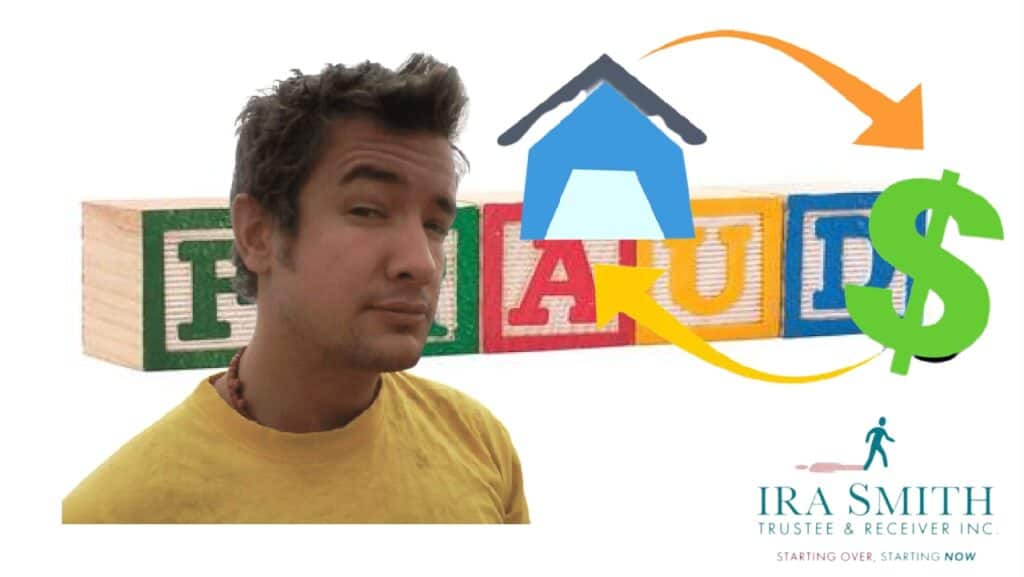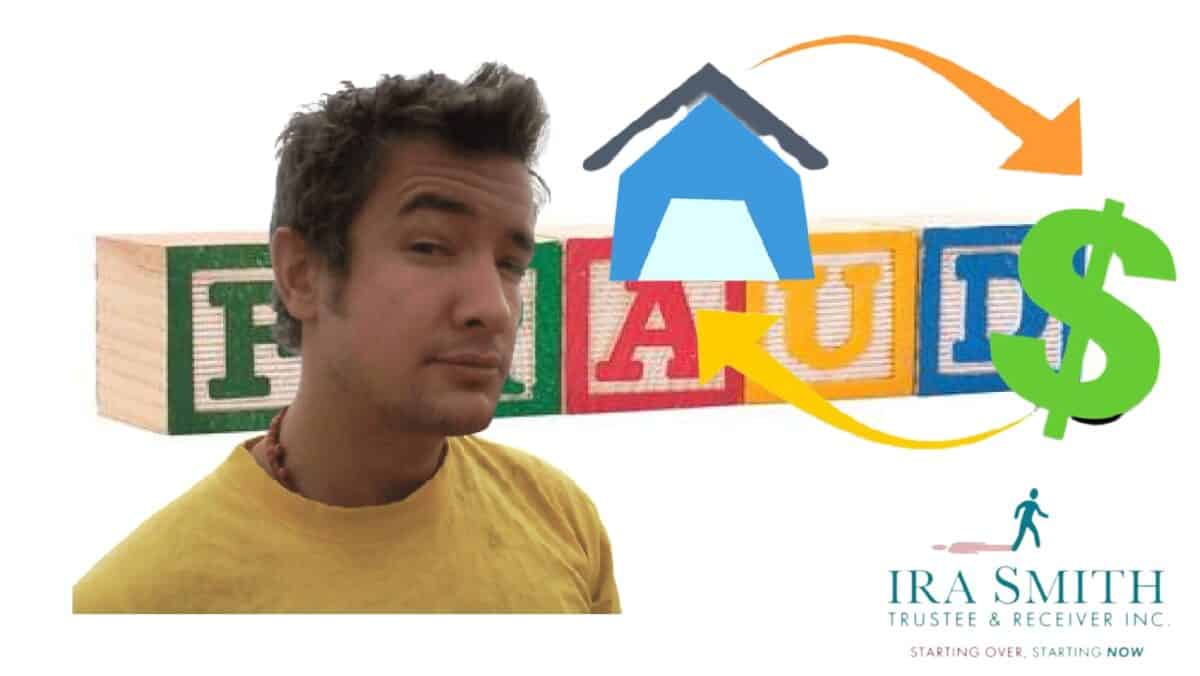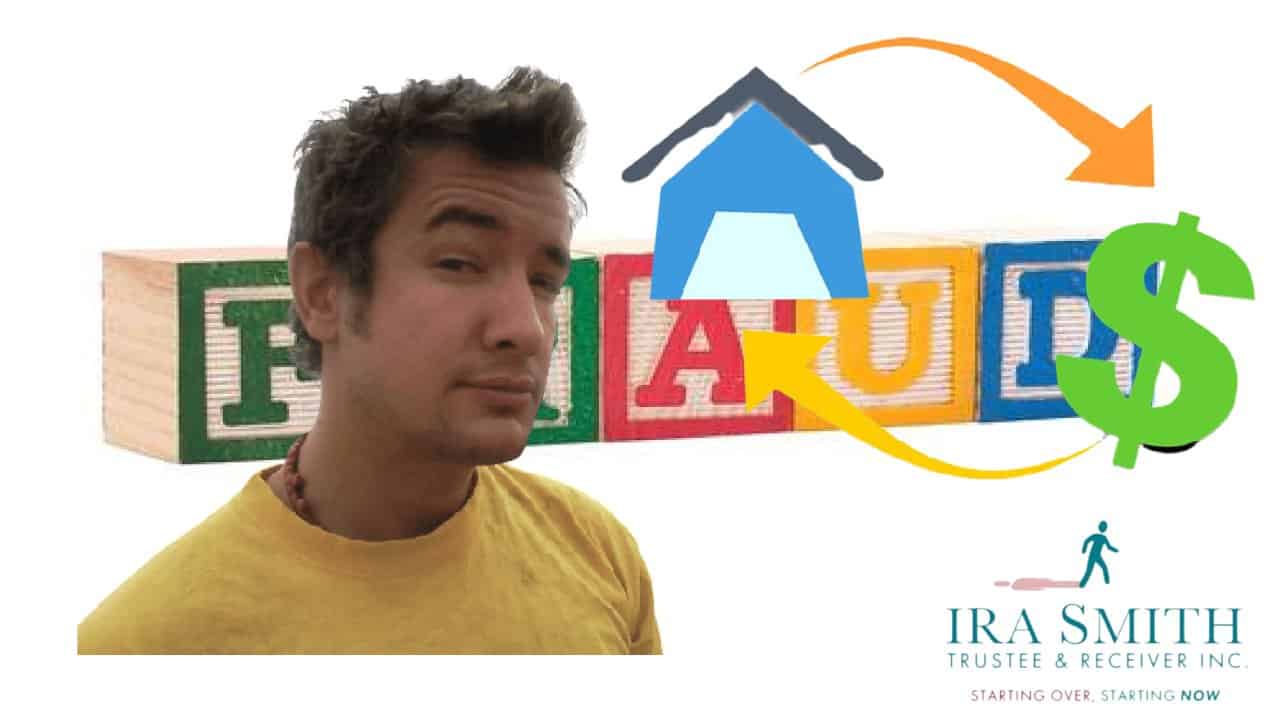Thank you for reading our Brandon's Blog. Check out our AI insolvency bot on this page and don't forget to subscribe!
- Mortgage fraud: What everyone needs to know
- Mortgage fraud: Seriously though, one in five?
- What are the most common schemes that can be classified as mortgage fraud?
- This mortgage fraud case may be of interest to you
- The income tax arrears real estate fraud
- Why wasn't this mortgage fraud detected?
- The court case involving the detection of mortgage fraud
- Why is section 178(1) of the BIA so important?
- What happens if you commit this kind of mortgage fraud and then go bankrupt, according to the Court of Appeal for Ontario?
- What are the consequences of mortgage fraud debt in Canadian bankruptcy?
- Call us now for a no-cost initial consultation.
Mortgage fraud: What everyone needs to know
There are 2 kinds of mortgage fraud. One is usually associated with identity theft. Someone steals your identity and has enough of your personal information to make a mortgage loan application and get approved for a mortgage loan registered against your property.
They take the money and don’t make any mortgage payments. The mortgage quickly goes into default and an innocent person is left with a mortgage they never applied for registered against their home and in default. This is a serious problem, but, not the one I am writing about in this mortgage fraud Brandon’s Blog.
As you can see, both an innocent person and a lender can become a victim of mortgage fraud. In this Brandon’s blog post, I will describe it a bit more and tell you about a recent decision of the Court of Appeal for Ontario about a civil mortgage fraud case.
Through this case discussion, you will learn why someone who is caught perpetrating a fraud scam cannot use the Canadian bankruptcy system to get out of the debt. Rather, that debt will follow them for life.
Mortgage fraud: Seriously though, one in five?
The Financial Services Commission of Ontario advises everyone to be vigilant against mortgage fraud. They state that it usually occurs when people falsify, misrepresent, or exaggerate information on their mortgage applications in order to obtain financing that they would not otherwise be eligible for.
It can be the person’s own idea and action or, they could have filled out their application truthfully and then were coached by one or more mortgage brokers or real estate professionals. They are told that without modifying the application they will not be approved for the mortgage and will not be able to buy a home.
A study by Equifax Canada found that suspected fraudulent mortgage applications have increased by 52 percent in Canada since 2013, with Ontario seeing the majority. The rising cost of homes has made it difficult for many people to afford one, which has led some to resort to fraudulent means in order to get the necessary mortgage funding.
According to a 2017 study from Equifax Canada, 13% of Canadians believe that telling a little white lie is perfectly acceptable if it means getting the house they want. Equifax Canada also reported that in 2019, 23 percent of millennials said it was totally acceptable to lie about their annual income when applying for a mortgage. I wonder what the percentage of people looking to score their dream home and are not afraid of bending the truth a little would be today?
As interest rates go up and borrowing rules get stricter, it becomes harder for people to achieve their homeownership goals. It’s estimated that 20% of all mortgage applicants engage in some form of mortgage fraud.
What are the most common schemes that can be classified as mortgage fraud?
One person’s little white lie that might not seem like a big deal to them, could be another person’s idea of a mortgage fraud scam. It all comes down to everyone’s honesty and conscience. When looking at residential mortgage fraud, which is a serious issue, there are generally three main schemes.
In Canada, do lenders check for owner occupancy?
Not really. Owner occupancy may not be as it seems. It is easier to get a mortgage approved for an owner-occupied home than for a rental investment property. Owner occupancy fraud is a common scheme.
Forging owner occupancy is pretty easy for a home buyer. All they need to do is tick the “yes box” when asked on the application if the home will be owner-occupied. The person will also need to be OK with swearing a false affidavit that the home will be owner-occupied. After that, the person should be good to go.
Once the loan is made and the real estate transaction is complete, there’s no need to worry about anyone checking up on the borrower or the property. There’s no need to try and create the illusion of owner occupancy. Foreign buyers have been known to either hire the services of a person or use a relative resident in Canada to act as a straw buyer.
Shady mortgage brokers or crooked mortgage agents
Falsified documents for employment and income are often fabricated by mortgage brokers/agents in a way that will pass the approval process of certain private lenders or certain institutional mortgage lenders.
You probably remember that in 2015, Home Capital Group stopped using 45 brokers because their business activities were found out that those brokers had engaged in fraudulent activities committing $2 billion worth of mortgage fraud using these techniques.
Debt shell game
People with too much debt may not be able to qualify for a mortgage because of those debts. They take out a loan from family or friends and pay off those debts. The new debts replacing the old ones don’t show up on a credit search or anywhere else. They don’t include those new loans on their mortgage application. This causes their financial ratios to look much better than the reality. They look good enough to qualify for that mortgage loan.
The problem of course with this kind of mortgage fraud is that a person who rearranges their debt like this and completes a false mortgage application may not be able to keep up with their mortgage payments as they will also be under pressure to repay their friends and family first. The eventual mortgage default may not be a problem for the lender in a rising real estate market, but that kind of market is not always the case.
This mortgage fraud case may be of interest to you
This court case about civil mortgage fraud you are really going to like. The Court of Appeal for Ontario released its decision on July 28, 2022. The defendants appealed the decision of the motion judge. I was astonished to see the lengths these defendants went to, which the court determined constituted a consumer mortgage fraud scheme not released by a discharge from bankruptcy.
It is the fascinating case of M.O.S. MortgageOne Solutions Ltd. v. Heidary, 2022 ONCA 561 (CanLII). The mortgagee originally provided funds to the mortgagor which were secured by a third mortgage that was ranked behind the first mortgage held by Manulife Financial. There were also various Minister of National Revenue (MNR) liens that were registered on the title against the property.
The mortgagor asked the mortgagee to provide additional funds to him to help with the payment and consolidation of his debts. The parties agreed that the mortgagor would use the funds to pay off the MNR liens so that the mortgage would now become a second mortgage.
The income tax arrears real estate fraud
The mortgagor directed the mortgagee’s representative to an individual, “Dave Erwin”, whom he represented as his Canada Revenue Agency (“CRA”) collection officer. This referral came as a result of the mortgagee’s need to independently confirm the amount of the MNR liens and arrange for payment, before making any advances.
After speaking with “Dave Erwin”, the mortgagee advanced the amount of $296,418.73 to the MNR. However, after the respondent advanced these funds, it was discovered that the so-called “CRA agent” was an imposter. The amount still owing and needed to discharge all the MNR liens was an additional amount of outstanding liens totalling $316,566.36. Consequently, the respondent’s mortgage remained in 3rd place.
It seems to me that the mortgagor was only able to commit this type of mortgage fraud because the mortgagee didn’t do their due diligence properly. Maybe they were just too eager to jump from third to second place. I don’t know, because I’m not involved in this matter.
Why wasn’t this mortgage fraud detected?
This mortgage fraud was not detected because the mortgagee was satisfied to rely on the confirmation supplied by “Dave Erwin”, including certain false documentation that did not reach the level of proper due diligence. How could it have been detected before advancing funds? Very simple. The mortgagee should have asked to see the original copy of the collection letters from CRA. That would have shown them the proper amount owing and the name and number of the real collections officer.
Alternatively, a simple search of the real property title would have uncovered the liens and their total amount. I am also not sure how you negotiate a priority agreement without the real amount owing ever having been discussed. Regardless, it happened.
There was still the additional amount ranking ahead of the mortgagee, and they were not in the position they thought they bargained for. From the mortgagor’s perspective, he bought some time with CRA since they received a significant paydown. He just traded one debt for another, but he obviously must have felt that owing CRA less and the mortgagee more was worth it.
The court case involving the detection of mortgage fraud
The mortgagee issued a statement of claim against the mortgagor, seeking various elements of relief including possession of the property due to the default under the priority agreement. The mortgagee also sought a declaration that any judgment against their borrower will survive any subsequent assignment in bankruptcy which will not be released by his bankruptcy discharge.
The mortgagor served a notice of intent to defend but never filed a statement of defence because the parties ultimately agreed to a consent judgment. Both parties were represented by counsel. The October 10, 2018 judgment required the mortgagor to pay $784,250 to the mortgagee. It did not have any wording that the claim would survive a discharge from bankruptcy.
The mortgagor then filed an assignment into bankruptcy and any enforcement by the mortgagee under the judgment automatically stayed under the provisions of the Bankruptcy and Insolvency Act (Canada) (BIA). The mortgagee brought a motion seeking a declaration that the debt to the consent judgment survived the bankruptcy and the stay proceedings were no longer effective with regard to the judgment. The motion judge, who had also granted the consent judgment, found that the pleadings raised the issue of fraud and granted that motion.
The bankrupt appealed this finding.
Why is section 178(1) of the BIA so important?
In the next section, you’ll see how section 178(1) of the BIA becomes so important. I’ve written about this section of the BIA many times before. In the simplest of terms, this is the section of the BIA that outlines the kinds of debts that aren’t discharged when the person gets his or her discharge from bankruptcy.
Any outstanding debt included in this section will remain with the debtor indefinitely. The only debts that will be discharged are those that are not included in this section of the BIA.
In the next section, you will see that sections 178(1)(d) and (e) are being argued over. You should know that a bankruptcy discharge does not extinguish certain debts, such as:
- Any debt or liability as a result of fraud, embezzlement, misappropriation, or defalcation while acting in a fiduciary capacity (178(1)(d)).
- If you obtain property or services by means of false pretenses or fraudulent misrepresentation, that incur debt or liability, other than one that arises from an equity claim (178(1)(e)).

What happens if you commit this kind of mortgage fraud and then go bankrupt, according to the Court of Appeal for Ontario?
In his appeal, the bankrupt submitted that the motion judge erred in declaring that the mortgagee’s judgment debt was not released pursuant to s. 178(1)(e) of the BIA. The mortgagee had only pleaded relief under s. 178(1)(d) of the BIA and it was unfair to him to grant relief not contained in the statement of claim.
Additionally, the bankrupt contended that the motion judge was incorrect in concluding that he had admitted to fraud by consenting to judgment, as the judgment itself made no mention of fraud or that the judgment would remain valid after he was discharged from bankruptcy.
The bankrupt maintained that, unless fraud was pleaded, it could not support a finding that a debt was not released by the debtor’s bankruptcy under s. 178(1) of the BIA. In any event, the bankrupt argued that fraud is not a reasonable inference arising from the pleadings.
The appellate court ruled against the bankrupt. The three-justice panel decided that the motion judge did not make any errors in providing relief under s. 178( 1 )(e) of the BIA. The decision was consistent with the pleadings and consent judgment. There was no unfairness to the bankrupt.
In order to obtain a declaration that a judgment survives a bankrupt’s discharge under s. 178(1) of the BIA, the claimant does not need to specifically refer to s. 178 in the pleadings on which the judgment is based. They relied on a 2018 decision of the Court of Appeal for Ontario to make this finding.
The bankrupt’s mortgage fraud and bankruptcy scheme was an abysmal failure. He was dealt a heavy blow.
What are the consequences of mortgage fraud debt in Canadian bankruptcy?
As outlined above, any debt falling under section 178(1) of the BIA will not be released when the bankrupt gets his or her discharge. The debt arising from mortgage fraud will follow the debtor for life.
This fraudulent activity is also a criminal offence. If you are being tempted or persuaded to commit mortgage fraud, you should get proper legal advice from a legal professional before making any decisions.
I hope you enjoyed this Brandon’s Blog. Are you in need of financial restructuring? The financial restructuring process is complex. The Ira Smith Team understands how to do a complex restructuring.
However, more importantly, we understand the needs of the entrepreneur or the person who has too much personal debt. You are worried because you are facing significant financial challenges.
It is not your fault that you are in this situation. You have been only shown the old ways that do not work anymore. The Ira Smith Team uses new modern ways to get you out of your debt troubles while avoiding bankruptcy. We can get you debt relief freedom.
The stress placed upon you is huge. We understand your pain points. We look at your entire situation and devise a strategy that is as unique as you and your problems; financial and emotional. We know that we can help you the way we take the load off of your shoulders and devise a debt settlement plan.
We realize that people and businesses in financial difficulty need practical advice and a workable solution in an easy-to-understand financial plan. The Ira Smith Team knows that not everyone has to file for bankruptcy in Canada. Most of our clients never do, as we are familiar with alternatives to bankruptcy. We assist many people in finding the relief they need.
Call or email us. We can tailor a new debt restructuring procedure specifically for you, based on your unique economic situation and needs. If any of this sounds familiar to you and you’re serious about finding a solution, let us know.


